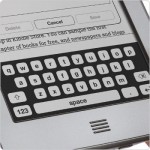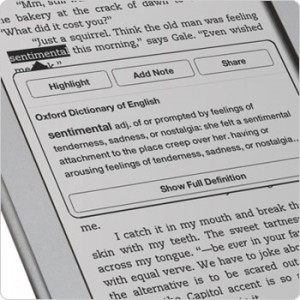Kindle: A Writer’s Secret Weapon
 Oops. I guess it’s not so secret anymore, is it? But I couldn’t help writing a piece about a whole new way of novel writing/editing. An out-of-the-box approach, if you will. And it all started when I purchased my Kindle Touch in the fall of 2011. (Note: Everything I share here will work with the newer Paperwhite and Kindle Fire—really, any of the models that feature a touch screen.)
Oops. I guess it’s not so secret anymore, is it? But I couldn’t help writing a piece about a whole new way of novel writing/editing. An out-of-the-box approach, if you will. And it all started when I purchased my Kindle Touch in the fall of 2011. (Note: Everything I share here will work with the newer Paperwhite and Kindle Fire—really, any of the models that feature a touch screen.)
Anybody who knows me well knows that I love my Kindle. At first, of course, I loved it only for reading books, mostly novels. But soon I realized it’s features were especially helpful in other realms.
Some may not know that my day job is book editing. Some days I literally sit at my desk for eight to ten hours. Literally. Yes, I do take standing breaks, but I can’t always avoid the occasional back or neck ache. Well, one day I got a bright idea. Why not get away from my desk and office chair and edit a book using my Kindle’s notes and touch-screen functions?
Simply by brushing my finger across the screen, I can highlight a word or a group of words—even a full paragraph—and apply a highlight or attach a note.
 Using the touch-screen keyboard, I can then type in my comment as if I’m texting on a smartphone. Seriously, it’s that easy. “uncl” is a common note for “unclear.” “pov” works for “point of view.” Another frequent one is “cut.” Just a few keystrokes, and I’m good. Granted, I wouldn’t recommend trying to write long passages this way, but the more I use the keyboard, the faster and more accurate I become. I’ve inserted whole sentences with ease.
Using the touch-screen keyboard, I can then type in my comment as if I’m texting on a smartphone. Seriously, it’s that easy. “uncl” is a common note for “unclear.” “pov” works for “point of view.” Another frequent one is “cut.” Just a few keystrokes, and I’m good. Granted, I wouldn’t recommend trying to write long passages this way, but the more I use the keyboard, the faster and more accurate I become. I’ve inserted whole sentences with ease.
Best of all, I can give my neck and back a much-needed rest. I can edit my book while lying on the couch in my living room or slouching on one of the Adirondack chairs on my deck—as if I’m simply reading a novel. If I’m unsure of a word, I can just hold my finger on a word, and the Kindle dictionary pops up, providing instant clarity.
Wow. Who would have thought that editing a novel could be this easy?
If I want, I can even turn on the Text-to-Speech feature and let my Kindle read my novel back to me—like an audiobook. I can close my eyes and just imagine I’m hearing someone else’s story. Hearing the synthesized voice read my story back to me brings a whole new perspective to the flow and cadence of my words. You should give it a try.
Now I’m reading through the 80k words of my as-yet-unfinished third novel (the subject matter of which remains supersecret for now). I’m so thankful for my Kindle and never dreamed when I bought it that it would become such an integral part of my novel-writing process. I think I actually use it more for editing than reading.
I have only one gripe. What I haven’t yet discovered is how to electronically get those corrections back into my Microsoft Word file. If anybody knows a trick, I’d love to know it. I tried http://clippingsconverter.com/, but I’m not satisfied. Currently, I have to compare corrections in my Kindle to the Word document on my computer screen. This step isn’t the end of the world, but surely someone somewhere has found an easier way.
What about you? Do you have an e-reader? If you’re a writer, have you ever tried to edit your own text using a Nook or Kindle? If so, what has your experience been like? Do you have any other tips to share?
Note: Amazon.com didn’t compensate me in any way to write this article promoting their products. I offer these tips simply to share the knowledge with my fellow authors. I hope the article is helpful.











I use an iPad, and I haven’t tried editing with the Kindle app, but I have used the Goodreader app and a stylus to mark up pdf galleys. Love it. I also got an app called CloudOn that edits Word documents, but I haven’t used it on a large scale yet. Reading on the tanlet is way easier than on the computer.
Typing on the *tablet*, though — not so easy. 😉
Hi, Kristen
I’m glad you found something that works for you. I don’t use a tablet and don’t really know what I’m missing.
Adam
Pingback: Is Rushing Creativity Ever the Right Choice? - |
I love reading my novel on the Kindle for editing and proofreading purposes. It’s really handy for proofreading because you can make the type larger and catch all the little punctuation mistakes. I don’t, however, put any notes inside my Kindle document since the time I went into my Kindle document and found all my notes had disappeared. I lost all my notes and couldn’t retrieve them. Since then I hand write them on a notepad and then go to my Word document and transfer my notes. It’s tedious and time consuming, but I was so spooked about losing all my notes that I don’t risk putting anything inside the Kindle document. Never thought about the text-to-speech aspect of editing on the Kindle. I’ll have to give that a try.
I personally had been seeking for recommendations for my very
own website and came across your own article, “Kindle: A Writer’s Secret Weapon – |”, do you really care in cases where I implement a number of of your tips? Thanks a lot ,Marty
Hi, Adam
The Kindle is one great invention, isn’t it? It has made many readers and writers happy especially with some of its cooler features. A feature that most like too is the ability to make annotations and highlights and access these online for future reference.
There is an iOS app called Snippefy (http://www.snippefy.com) that will be released soon which will make it convenient to access notes and highlights all in one place. Kindle users will be able to integrate these to social media, Evernote, Dropbox and email.
This will be something great and I wanted to share this with you as I believe you will find if useful.
Thank you
Nathan
Thank you for your response, Nathan. Will this app be only for Mac? Just wondered when you said “iOS app.” Thanks.